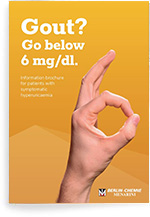What are the symptoms of gout?
Gout develops over several years when uric acid levels are above 6 mg/dl, or 360 µmol/l. This stage of the disease is known as "hyperuricaemia" and shows no signs or symptoms.
The first signs and symptoms of gout often occur during the night in the form of a gout attack in a joint (usually the big toe).
During a gout attack, you may experience:
- Intense joint pain;
- Difficulty moving the affected joint;
- Lingering discomfort, inflammation, swelling or red colouring of the affected area.

When hyperuricaemia is left untreated, large amounts of uric acid crystals can build up around the joints as well as in the ears or the tissue beneath the skin – this is known as "gouty tophus" or "tophus”.
If you experience a gout attack or gout symptoms, please consult a physician. Your doctor will prescribe you medication suitable to alleviate the pain and control the disease. Since gout attacks often occur at night, do not hesitate to visit the medical emergency service.

